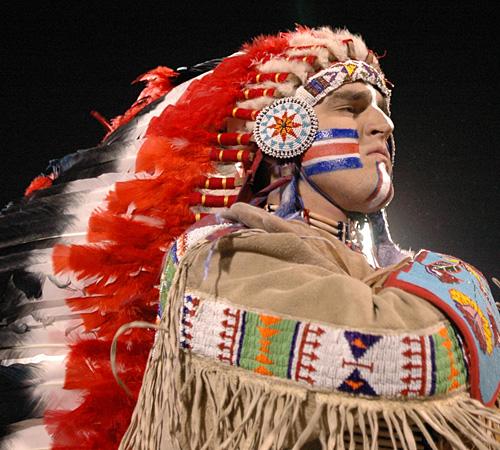Two years into Chief’s retirement, no plans exist to create UI symbol
Feb 20, 2009
Nearly two years after Chief Illiniwek was retired, the University is the only school in the Big Ten conference that does not have a mascot. But that was true even before the retirement of the Chief, which was never considered a mascot.
The University has been without a mascot for 142 years, and assistant athletic director Kent Brown said the University might not have adopted a mascot because there was nothing that fit in well with the name Fighting Illini.
“Our nickname didn’t really allow for one,” Brown said. “(Other schools have) an immediate connection to something.”
As the two-year anniversary of Chief Illiniwek’s last dance approaches, many students are wondering if the University will adopt a new mascot or symbol.
Roberto Martell, junior in LAS and president of Students for Chief Illiniwek, said the University should not adopt a new symbol or a mascot because the Chief was a long-standing tradition and should not be replaced.
Get The Daily Illini in your inbox!
“I believe that if the University were to adopt a mascot … people would reject it. We’ve had Chief for so long and he’s so well respected,” Martell said. “Any (other) symbol would just feel cheap.”
The University has never had a cartoonish mascot like Michigan State University’s spartan or the University of Wisconsin’s badger, Martell said.
“They just have a different atmosphere and a different feel to those universities,” he said. “I don’t think that would fit at the University of Illinois.”
In the early 1980s, the University attempted to win fan support for a mascot. A chicken, wearing an Illinois shirt, went to a basketball game but was not well received, Brown said.
“(It was probably) some way to generate excitement while the game was going on,” Brown said. “(But) it did not go over well.”
Martell said he heard the chicken received boos from the audience.
Brown said there has been no discussion of adding a mascot, and he does not believe there will be any discussion in the near future.
“It would be very difficult considering some of the emotion … what the campus and our fans and the community went through with Chief Illiniwek,” Brown said.
Debates about whether to continue using the Chief occurred more than 20 years before the Board of Trustees voted in February of 2007 to retire the symbol, said Michele Thompson, secretary of the Board of Trustees.
She said people on both sides of the debate had a lot of reasons why the University should retain the Chief or retire him. Some University supporters say he preserves Native American history, while others say his image is not flattering to Native American culture, Thompson added.
The vote came after the National Collegiate Athletic Association sent a letter to the University in 2005, asking the University to stop using Chief Illiniwek as a symbol. Other schools using Native American mascots were sent similar letters. The University unsuccessfully appealed to the NCAA to be allowed to keep the Chief before finally voting on whether to remove him.
In February of 2007 the NCAA announced that any schools failing to comply with its mandate would not be allowed to host postseason NCAA events, including tournaments.
“In order to give the athletes the opportunity to participate in postseason sports (we had to comply),” Thompson said.
After the appeal to the NCAA failed, the Board of Trustees decided to stop using the Chief as a symbol. While the NCAA has just recently forced schools to change mascots, Stanford University decided to change its mascot in 1972. Jim Rutter, an athletics archivist at Stanford, said Stanford adopted the name “Indians” in 1930. In 1972, Stanford president Richard Lyman decided to stop using the name Indians. The student body voted in favor of this recommendation.
Rutter said the movement to discontinue the Indian name and mascot, portrayed by a student in a similar fashion to the Chief, occurred when the president’s wife lobbied on behalf of a group of Stanford’s Native American students.
“It caused, as you might imagine, quite the controversy, as many students, athletes and alumni were quite attached to the Indians’ (name) place in Stanford’s proud tradition, history and heritage,” Rutter said.
In the 1980s, the color “Cardinal” was chosen in a referendum to be Stanford’s nickname.
Bob Carruesco, director of game day promotions and entertainment at Stanford, said the mascot is still a point of debate for the Stanford community. He said that alumni often still refer to Stanford as the Indians. However, he said, current students do not even know about the Indians.
“In some depictions the Indian had exaggerated and stereotypical features,” Rutter said.
“Some of the Indian symbols used to promote the sports teams were quiet backward and could easily be deemed offensive.”
Brown said mascots do not affect a team’s performance but pump the crowd up. He added that mascots are for the fans and act as ambassadors for schools.
“The mascot can certainly add to the atmosphere at games,” Brown said.
Martell does not think a new mascot would be accepted and incorporated into the University’s identity.
“If we were to do something with (a new) mascot, would that change what we’ve been?” Martell asked.






